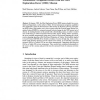Free Online Productivity Tools
i2Speak
i2Symbol
i2OCR
iTex2Img
iWeb2Print
iWeb2Shot
i2Type
iPdf2Split
iPdf2Merge
i2Bopomofo
i2Arabic
i2Style
i2Image
i2PDF
iLatex2Rtf
Sci2ools
ISER
2004
Springer
2004
Springer
Autonomous Navigation Results from the Mars Exploration Rover (MER) Mission
In January, 2004, the Mars Exploration Rover (MER) mission landed two rovers, Spirit and Opportunity, on the surface of Mars. Several autonomous navigation capabilities were employed in space for the first time in this mission. In the Entry, Descent, and Landing (EDL) phase, both landers used a vision system called the Descent Image Motion Estimation System (DIMES) to estimate horizontal velocity during the last 2000 meters (m) of descent, by tracking features on the ground with a downlooking camera, in order to control retro-rocket firing to reduce horizontal velocity before impact. During surface operations, the rovers navigate autonomously using stereo vision for local terrain mapping and a local, reactive planning algorithm called Grid-based Estimation of Surface Traversability Applied to Local Terrain (GESTALT) for obstacle avoidance. In areas of high slip, stereo visionbased visual odometry has been used to estimate rover motion. As of mid-June, Spirit had traversed 3405 m, of wh...
Horizontal Velocity | ISER 2004 | Mars Exploration Rover | Robotics | Several Autonomous Navigation |
| Added | 02 Jul 2010 |
| Updated | 02 Jul 2010 |
| Type | Conference |
| Year | 2004 |
| Where | ISER |
| Authors | Mark W. Maimone, Andrew Edie Johnson, Yang Cheng, Reg G. Willson, Larry Matthies |
Comments (0)

